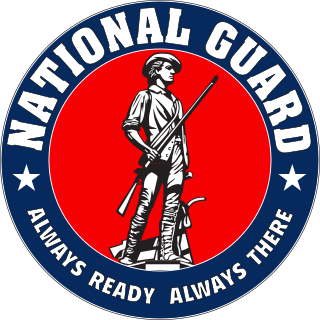
The National Guard is a state-based military force that becomes part of the U.S. military's reserve components of the U.S. Army and the U.S. Air Force when activated for federal missions. It is a military reserve force composed of National Guard military members or units of each state and the territories of Guam, the Virgin Islands, Puerto Rico, and the District of Columbia, for a total of 54 separate organizations. It is officially created under Congress's Article 1 Section 8 ability to "raise and support armies". All members of the National Guard are also members of the organized militia of the United States as defined by 10 U.S.C. § 246. National Guard units are under the dual control of state governments and the federal government.

In the United States, state defense forces (SDFs) are military units that operate under the sole authority of a state government. State defense forces are authorized by state and federal law and are under the command of the governor of each state.

The New York Guard (NYG) is the State Defense Force (SDF) of New York State, and is one of the four branches of the New York Military Forces (NYMF). Originally called the New York State Militia, it can trace its lineage back to the American Revolution and the War of 1812.

The New York State Division of Military and Naval Affairs is responsible for the state's New York Army National Guard, New York Air National Guard, New York Guard and the New York Naval Militia. It is headed by Adjutant General of New York Major General Raymond F. Shields Jr., appointed on October 1, 2018. with the Governor of New York Kathy Hochul serving as Commander in Chief of the state's militia forces. It is part of the New York State Executive Department.

The Georgia State Defense Force is a professionally trained volunteer component of the Georgia Department of Defense, serving in support of the national and state constitutions under direction of the governor and the adjutant general of Georgia. As a State Defense Force (SDF), the GSDF serves alongside the Georgia Army National Guard and the Georgia Air National Guard. The mission of the GSDF is to provide volunteers to assist government agencies and civil relief organizations during emergencies.
Awards and decorations of the state defense forces are presented to members of the state defense forces in addition to regular United States military decorations and state National Guard military decorations. Each of the state governments of the United States maintains a series of decorations for issuance to members of the state defense forces, with such awards presented under the authority of the various state adjutants general and/or respective state defense force commanders.

The Arizona National Guard is the National Guard of the American state of Arizona. It consists of the Arizona Army National Guard and the Arizona Air National Guard.
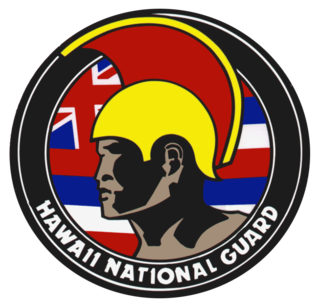
The Hawaii National Guard consists of the Hawaii Army National Guard and the Hawaii Air National Guard. The Constitution of the United States specifically charges the National Guard with dual federal and state missions. Those functions range from limited actions during non-emergency situations to full scale law enforcement under martial law when local law enforcement officials can no longer maintain civil control. The National Guard may be called into federal service in response to a call by the President or Congress. When National Guard troops are called to federal service, the President serves as Commander-In-Chief (CinC). The federal mission assigned to the National Guard is: "To provide properly trained and equipped units for prompt mobilization for war, National emergency or as otherwise needed."
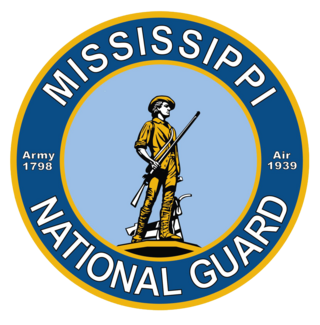
The Mississippi National Guard (MSNG), commonly known as the Mississippi Guard, is both a Mississippi state and a federal government organization, part of the United States National Guard. It is part of the Mississippi Military Department, a state agency of the government of Mississippi. The Adjutant General of Mississippi (TAG), Major General Janson Durr Boyles, serves as the executive director and is subordinate to the Commander-in-Chief, the Governor of Mississippi, in matters relating to the department and the state militia forces.

The Connecticut Military Department is a state agency of the government of Connecticut. Its primary components are the Connecticut Army National Guard, the Connecticut Air National Guard, and four companies of the state militia. The Military Department of the State of Connecticut traces its origins to May 11, 1637, when the "General Courts" established a military arm of the provincial government. In 1939, the State's Military Department was established to consolidate the offices of Adjutant General, Quartermaster General, Armory Board, and Armory Board Inspector.

The Florida National Guard is the National Guard force of the state of Florida. It comprises the Florida Army National Guard and the Florida Air National Guard.

The Kansas National Guard, is the component of the United States National Guard in the U.S. state of Kansas. It comprises both the Kansas Army National Guard and the Kansas Air National Guard. The Governor of Kansas is Commander-in-Chief of the Kansas National Guard when in state use. The State's highest-ranking military commander, the Adjutant General of Kansas, serves as the military head of the Guard and is second only to the Governor.
The Maine Department of Defense, Veterans, and Emergency Management (DVEM) is a government agency in Maine. It comprises the two components of the Maine National Guard, the Maine Army National Guard and the Maine Air National Guard, the Bureau of Veterans' Affairs, the Maine Emergency Management Agency, and when it is active, the Maine State Guard. The Adjutant General of Maine, Brigadier General Doug A. Farnham, commands the Maine National Guard and serves as the State's Commissioner of Defense, Veterans, and Emergency Management (DVEM). The Maine Army and Air National Guard has responded to every call of the State and Nation since before the Revolutionary War. Their soldiers and airmen are trained to high standards and are ready to respond to combat missions, domestic emergencies, counterdrug efforts, reconstruction missions and more.
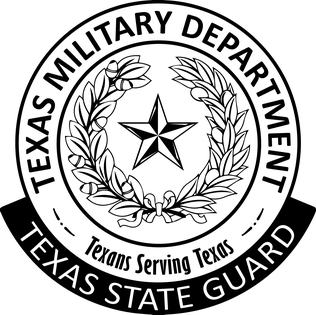
The Texas State Guard (TXSG) is part of the state military force of Texas, and one of three branches of the Texas Military Forces. Along with the other two branches, the TXSG falls under the command of the Governor of Texas and is administered by the Adjutant General of Texas, an appointee of the Governor. The other two branches of the Texas Military Forces are the Texas Army National Guard and the Texas Air National Guard.
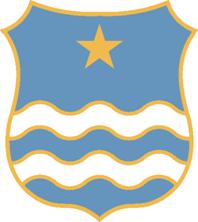
The Minnesota Army National Guard, along with the Minnesota Air National Guard, is an element of the Minnesota National Guard. The Constitution of the United States specifically charges the National Guard with dual federal and state missions. In fact, the National Guard is the only United States military force empowered to function in a state status. Those functions range from limited actions during non-emergency situations to full scale law enforcement of martial law when local law enforcement officials can no longer maintain civil control. The National Guard may be called into federal service in response to a call by the President or Congress.

The South Carolina State Guard (SCSG) is the designated state defense force for the state of South Carolina.

The Alaska State Defense Force (ASDF) is the state defense force of Alaska. It is one of 18 such forces in the United States. The Alaska State Defense Force is administered under the Alaska Department of Military and Veterans Affairs, but is headed by a commander who reports directly to the governor of Alaska, who acts as commander-in-chief of the state defense force.

The New Mexico State Defense Force, formerly the New Mexico State Guard, is part of the armed forces of the U.S. state of New Mexico. It is a reserve military force that works parallel to the state's National Guard. Authorized under the constitutions of the United States and New Mexico, the NMSDF is organized as an internal security and emergency services reserve force.

The Puerto Rico State Guard is the state defense force of Puerto Rico that operates under the sole authority of the governor of Puerto Rico who, in turn, delegates such authority to the Puerto Rico Adjutant General. The Guard's secondary purpose is to assume the state mission of the Puerto Rico National Guard in the event that the National Guard is mobilized. The first incarnation of the PRSG was created in 1941 in response to World War II and it disbanded in 1946. The PRSG was revived in 1971 and has remained in continuous existence since then. It is one of the few state defense forces of the United States that has an air division.
The reserve components of the United States Armed Forces are military organizations whose members generally perform a minimum of 39 days of military duty per year and who augment the active duty military when necessary. The reserve components are also referred to collectively as the National Guard and Reserve.























